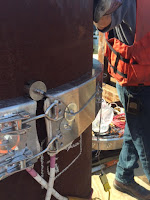 |
| Demand Pulse Welder |
One of the oldest welding technologies still in use today is resistor controlled arc welding. The technology is old, but when combined with more modern controls, provides exceptionally high quality performance. Resistor controlled arc welding incorporates edge-wound resistors using a special current-controlling alloy.
From the 1930’s until 1990, nearly all Multiple Operator Systems were the same general layout – a big bulk power supply, with “grids” connected by means of cable to form a system of distributed power. Originally designed for use in shipyards, this system minimized the use of high voltage primary power, distributing 75-80 volts of secondary voltage instead.
Historically, the most common application of resistor controls has been in Multiple Operator Welding Systems, widely used in shipyards and heavy construction. Nearly all the Nuclear Electric Power Plants were built using Multiple Operator Systems.
Big Four Manufacturing Company of Saint Louis, Missouri, pioneered the concept of connecting Multiple Operator systems in a complete loop configuration. This LOOP concept greatly improved the voltage stability of Multiple Operator systems, because with all the power connected to a single circuit, voltage drops were reduced or eliminated due to the nature of a DC circuit. In 1977, Big 4 Manufacturing introduced their innovative and very successful Series 77 Control.
After the Three Mile Island incident and the subsequent slowing of the Nuclear Power Industry, Big 4 decided it was in their best interest to expand into the general fabricating, refinery and petro-chemical markets. Their popular soft arc was great for most welding, but was inadequate on pipe root passes with 5P, then the most common method use for oil related pipe. To provide an arc better suited for pipeline, Big 4 devised a circuit to make their resistor grid “think” it was a Lincoln generator. They called this new system “Arc Ram”. Arc Ram worked beautifully with 5P and similar electrodes and led to the design of a MIG system which they called
Demand Pulse.
Not to be confused with ...
"Short-circuiting Metal Transfer" (Short Arc) welding was introduced by Linde in the late fifties for welding sheet metal. During the 1960s, short-arc became widely used, sometimes for the wrong applications. When using short-arc the wire can contact the molten weld pool resulting many times with the weld not fusing to the base metal. This is called a "cold lap". Cold lap associated with Short Arc became a reason why many welding shops won’t use “wire” welding processes on pressure welds. Unfortunately, mis-used Short Arc welding gave ALL GMAW welding on pressure welds a bad name.
Demand Pulse to the Rescue
Demand Pulse rarely extinguishes the arc. Metal transfers through the arc, and the arc’s are much shorter than those from Pulse Spray. The transfer occurs above the molten pool, so spatter doesn't explode from the puddle. It is a "constant current" process. The operator selects a base current, similar to some GMAW Pulse Spray applications, adjusts the wire feed speed to give the correct voltage, and begins to weld. Lower voltage will cause the puddle to freeze faster, higher voltage will cause the puddle to be more fluid.
In short arc, a current pulse is triggered by the short-circuit condition caused by the wire driving into the work piece. Demand Pulse forces the transfer to occur before short-circuit, at a voltage selected by the operator, above the weld pool. This has two important effects: the arc does not extinguish and the spatter level is greatly reduced because the molten tip of the wire does not contact the weld pool. Because the arc is not extinguished, cold laps are virtually eliminated.
Many reference books describe short arc as a "random pulse" method of welding. Random in the sense that the pulse is triggered as a function of wire feed speed. The faster the wire feed speed, the faster the short circuits (pulses). Demand Pulse is exactly the same, except it does not short!
This blog post was abstracted from a 2004 press release from Aftek Welders, the only remaining company providing resistor controlled welding machines, and parts supplier for all Multiple Operating Systems.
You can read the full version of "AFTEK – the Best Welders you never heard of…” here.
 Electric Heating Systems, Inc. (EHS), established in 1994 in Robbinsville, NJ, is a designer and supplier of turnkey, permanent low temperature heating systems for the electric power and tank fabricating industries. Later, this division's name was changed to Hotfoil, and the EHS division began manufacturing ceramic mat (pad) heaters, power consoles, and accessories for the heat treating industry.
Electric Heating Systems, Inc. (EHS), established in 1994 in Robbinsville, NJ, is a designer and supplier of turnkey, permanent low temperature heating systems for the electric power and tank fabricating industries. Later, this division's name was changed to Hotfoil, and the EHS division began manufacturing ceramic mat (pad) heaters, power consoles, and accessories for the heat treating industry. 








